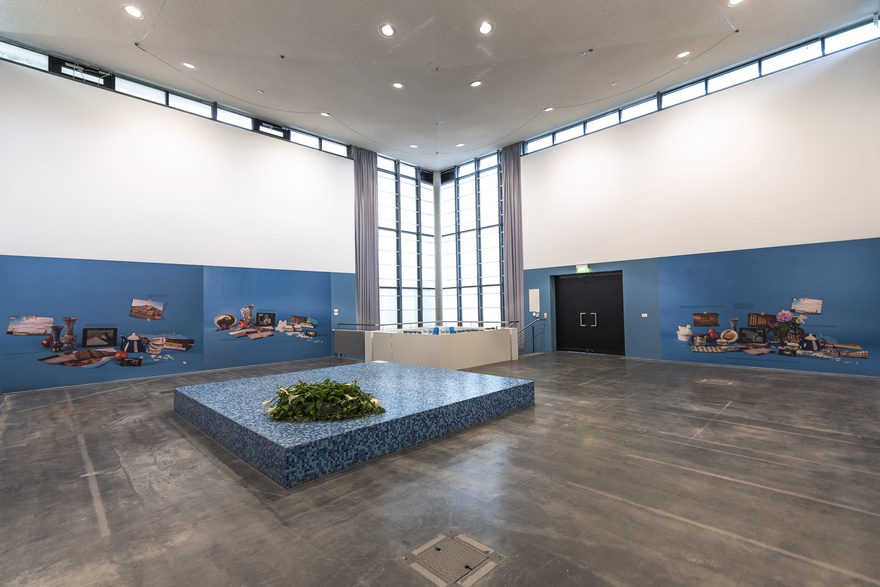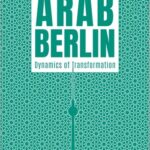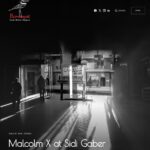Originally published in Ibraaz
II. On Nation Building: Alexandria, Egypt.
Mahmoud Khaled in conversation with Amro Ali
I have been familiar with Mahmoud Khaled’s artistic works for a number of years, and his creative output never fails to astound the observer. Alexandria, the city we both herald from, can often be a political tempest and urban dystopia that deepens a chronic melancholia within the public realm. This, in turn, foments nostalgia through the citizenry who long to live in a sepia-tinged so-called golden age. What romance is to Paris and ambition is to New York, nostalgia is to Alexandria. Yet perhaps because the city functions in a world of intangibles, one where the mythologized metropolis is drowned in a long glorious history that torments the human imagination; will as a result, ruthlessly press the artist, poet, writer, and thinker against established boundaries; at times breaking them.
Political theorist Fredric Jameson noted that nostalgia is an ‘alarming and pathological symptom’ of a modern world unable or unwilling to engage in any meaningful way with its own historicity. This is where Khaled’s work comes in: he seeks to engage this symptom by confronting the Alexandrian spectre of memory. His latest work A New Commission for an Old State (2016) propels the progenitor of nostalgia, memory, into a new site-specific exhibition. A form of commemoration that embodies complex narratives in the young artist’s new body of work, through three iconic artefacts within the Egyptian context.
The first is a gated summer resort in Alexandria called Maamoura built by the state shortly after Gamal Abdel Nasser came to power to accommodate the new elite of the ‘rebranded’ (post-1952) Egypt. The second is a landmark text titled Maamoura’s Victims written by Judge Hassan Jalal who was a harsh critic of the Egyptian monarchy. The third artefact is a 1961 film by Youssef Chahine titled A Man in My Life, which started production in Maamoura a few months after it officially opened in 1959. The story revolves around the life of a fictitious architect who is known for his remarkable modernist style and who has built one of Maamoura’s most memorable buildings, which is used as a backdrop in the opening scene of the film.
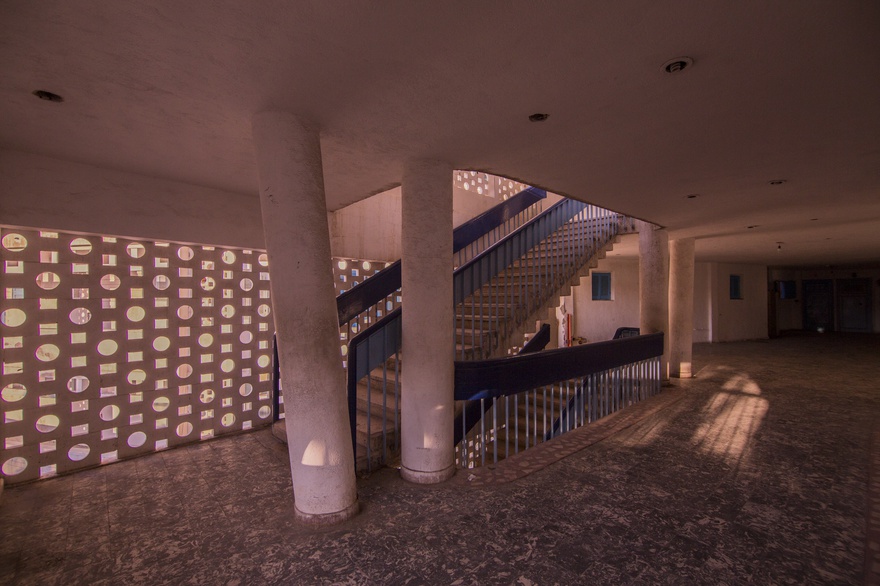 Mahmoud Khaled, A New Commission for an Old State, 2016. Detail, C Photograph (15cm X 10cm). Photo courtesy of the artist.
Mahmoud Khaled, A New Commission for an Old State, 2016. Detail, C Photograph (15cm X 10cm). Photo courtesy of the artist.
Amro Ali: Your recent solo exhibition in Germany last summer is highly fascinating and it certainly overlaps with my work in political sociology. The driving question that intrigues me is: Where does Alexandria, as an autonomous entity, fit in the artistic narrative that you have developed? My understanding of Nasser-era rebranding has more to do with how Alexandria was divorced from its Greco-Roman heritage, and pushed more towards its Arab heritage. I don’t see this as a phenomenon that happens immediately after 1952, but rather gains traction in the 1960s when, for example, Alexandria saw the rise of statues of Arab figures in the public space such as Ibn Khaldoun and Sayeed Darwish, among others. How does the rebranding in Mammoura fit in with this? When you speak of re-branding, is it a matter of the state homogenizing the entire landscape across the country, without any consideration for local factors and idiosyncrasies of a city?
Mahmoud Khaled: I also don’t see this rebranding as happening immediately after 1952. As you said it did take almost a decade for this process to physically and visually exist in the public sphere and Mammoura as a project is evidence of this, as it officially opened in 1959 and was promoted afterwards as one of the regime’s achievements towards the promised social democratic state and assuring the official support to the middle, working class and farmers.
We also know, this rebranding process was not only about erecting buildings with new architectural aesthetics and sculptures of significant Arab and national figures in public spaces, but included the establishment of agrarian reforms and ambitious industrialization programs that led to a period of infrastructure building and modern urbanization. There was a political need to have these social and architectural projects to form a new Egyptian identity that served the new elite of the republican era. Theses projects included housing complexes, theatres, cultural palaces, parks and summer resorts. Architecturally, aesthetically and functionally, then, all these projects were designed in sharp contrast to the lavish lifestyle of the former royal aristocracy which added a strong political connotation to the style of these buildings and projects, and more generally to the introduction of ‘Modernism’ in Egyptian architecture. At least that’s how I understand it.
Maamoura is located strategically next to the former royal Montaza palace and gardens, which I read as an intentional political statement to show that the new state can also design and build a protected gated space for its won elite. This beach resort is considered to be the prototype for modern bourgeois summer destinations and is one of the first gated community projects in Egypt, functioning as a city within the city with its architecturally unique residential villas, houses, and cabins mostly owned by generals, businessmen, and celebrities that came to form the new upper class. At the same time, more modest buildings were targeted towards the middle-class with public sector companies having access to properties that they rented out to their staff for affordable prices.
Mammoura Beach, Alexandria, 1995. Black and white promotional video of Al Mammoura resort project, found on YouTube.
AA: The problem of political branding is that it tends to destroy pluralism, as the state imposes a narrative from above, rather than allowing an organic story to develop through civil society. How does your understanding of branding, in an architectural sense, equate with oppression and the destruction of civic meaning?
MK: Personally, I don’t see any contribution from the civil society in this whole process at all; everything was done by the state to the people, and mainly most of the projects were executed by the army itself which is something happening until now and my generation can definitely relate to it.
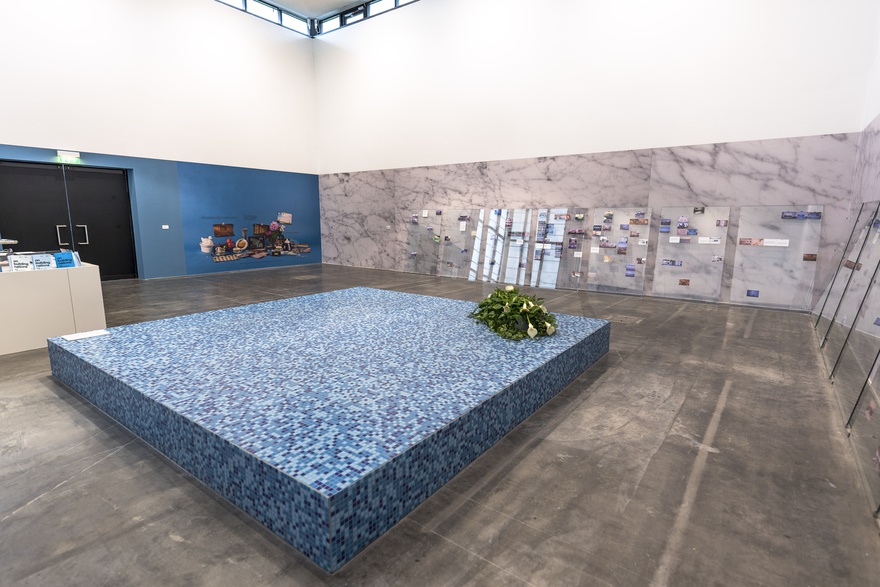 Mahmoud Khaled, A New Commission for an Old State, 2016. Installation view at Edith Russ Haus für Mediakunst, Oldenburg. Photo courtesy of the artist.
Mahmoud Khaled, A New Commission for an Old State, 2016. Installation view at Edith Russ Haus für Mediakunst, Oldenburg. Photo courtesy of the artist.
AA: You touch upon an important aspect regarding Youssef Chahine’s films. From my readings, the struggle between Alexandria and the state extended to films: for example, Nasser-era cinema tended to reflect narratives that domesticated Alexandria. This in turn subverted the city into the national narrative. Chahine’s films were not an exception, although it as only with his 1978 film Alexandria, Why? that he was able to challenge this trend, by breaking with the conventional narrative and realigning it with an emerging novel tradition that represented Alexandria as a place of “utopian desire.” The renowned director started to see a relative change in the political culture of 1970s Egypt – if not the Arab world – that enabled his cinema to “recognize and redress marginalized social elements within Arab national identity…[by revisiting and engaging] the cultural and historical elements of distinct groups he thought integral to the appreciation of a collective Arab identity.”[3]
In light of this, how much innovation and independence was Chahine allowed in the making of the 1961 film A Man in my Life? Was the film geared towards supporting Nasser’s project? Or did Chahine situate the idea of justice in a national (or perhaps nationalist) narrative at the expense of local civic factors?
MK: I think in this film Chahine tried to abstract the ideologies and the principles behind the “free soldiers” movement by staging a melodramatic love story that contains a lot of guilt, pain, and heroism to highlight the struggle for social justice amongst the working class (here, a group of fishermen in Alexandria) in the year of 1938, when the country was still a royal monarchy. It is very obvious to me how he was very influenced by these ideas, principles, and hopes for the establishment of a modern and socially equal state, like many other artists and intellectuals in Egypt at the time. For example, I still remember many of my painting professors in Alexandria who are associated with or known as the sixties generation of artists, were preoccupied with producing art that was heavily engaged with the ideas of social justice, class struggle and full independence from colonialism. I honestly don’t think these artists, including Chahine, were doing this work to compliment the political power, or as a sort of a contribution to the propaganda of the new regime. Rather, I think they – or let’s say most of them – believed in these ideas and wanted to dedicate their production to contribute to the cause.
This is, in fact, the most interesting point for me: how can we now look back at the art production of this period, especially given the radical shifts since 2011, to how we understand the regime today? How does viewing the situation as a continuation of the 1952 state, reshape our relationship with our home country?
In terms of innovation, I am not sure to what extent the film was an original, given it was an adaptation of the 1954 American film Magnificent Obsession by Douglas Sirk, But I am personally not so crazy about this idea of originality; I find it clever how Chahine kept the structure of the story from Sirk’s film but adapted the sociopolitical content in order to respond and engage with the political and ideological moment in Egypt at the time.
Video collage by Mahmoud Khaled of two films, both of which were important source material for him during the formulation of this comission: A Man in My Life, dir. Youssef Chahine, 1962, Egypt, and Magnificent Obsessions, dir. Douglas Sirk, 1954, USA.
AA: Fascinatingly, this recent body of work metaphorically touches upon building materials such as glass and marble, which you argue have been widely utilized in state-sanctioned architectural projects in Egypt over the past thirty years. Here, I specifically want to point to the piece A Rare Glimpse into the Recent Moments When People Lived in a World Turned Upside Down (2016) in which you used eight computer-generated images of carrara marble printed on wallpaper and sixteen double glass panels, accompanied by images and texts that occupied almost half of the space of the exhibition.
Is there a particular state logic behind utilizing building materials such as glass and marble? Does this have any relationship to Mubarak’s political projects and neoliberal policies?
MK: Yes it does. I wanted to do something physical, imaginative and semi-fictional, using material that would speak directly to the content of the installation. I decided to use the format of the memorial as a site from which to stage the content of the project; of course here, marble makes perfect sense, as a permanent noble and monumental material that has been used excessively in most of the governmental projects in Egypt during the past thirty or so years, which is of course, the era of Mubarak.
When I looked back at the use of the material and its existence in state-owned or run buildings, I started to see the sharp contrast between marble and the kind of modest, humble and relatively cheap building materials that was used in the late 50s and 60s by the regime. For me, this shows how the state wanted to manifest itself and assert it’s power architecturally and in public spaces, whilst pointing to the shift in aesthetics and values from the 60s to the 90s, and so I was keen for the installation to reflect this.
AA: The ‘Maamoura’s Victims’ text by Judge Hassan Jalal, published in Al Hilal Magazine in February 1955 just few years after the ’52 state’ started, presented a report on the atrocities, horrendous conditions and systematic tortures in a prisoner camp on the King’s properties, which later became the land on which Maamoura was built. It is an insightful artifact from a very romanticized period in the Egyptian and Alexandrian popular imagination. Would you say that your work in this regard is a strong statement against nostalgia?
MK: William E. Jones, who is one of my favorite artists said recently in an interview that ‘Nostalgia is a sympathetic feelin’‘[4] – and I completely agree with him.
Unfortunately, Alexandria has been always romanticized in the popular imagination. I can even sense this when I talk about the city with my friends and colleagues from Cairo. It’s something I used to be very sensitive about it. Nostalgia became the scary ghost that I tried to kill while I was developing and working on the exhibition, and I hope I did that – though I don’t know. I think the problem for us Alexandrians is that we have been over saturated with nostalgic narratives and representations of the city in books, films, and photographs (and now even on social media) but it’s still the city we live and work in. And so, it is hard to ignore the overarching sentimentality.
That is why I tried for a long time to avoid working on anything related to Alexandria and its history – near or far – because you can never escape the language and aesthetics of nostalgia when talking about the city in the field of artistic and cultural production. This idea shifted for me in 2011, when I saw everything in the city becoming highly politicized and very active, instead of being forever decaying and romantic; it was then that I realized that I can talk abut the city in a way I was unable to before, mainly because of my own self-censorship towards this fear of being nostalgic.
Jalal’s text was also a huge discovery for me – it made everything feel similar and yet different all at once, and that’s why I wanted to use it in full length in the installation. First of all, it gives us a glimpse of Maamoura when it was just an empty, neglected wasteland, and how even during this time (late 1940s/early 1950s) it was a stage for human rights violations, torture and the exertion of power by the state. Secondly, the fact that it was written by a judge, whose profession is to protect the values of social justice and dignity in society, he is also fully supporting the 1952 state (which I believe we are still living an extension and the continuation of this era).
I also think my fascination with the text has a lot to do with the fact that I was born around a bunch of structures, monuments, and buildings which are gradually vanishing from the cityscape, yet I still don’t know much about the socio-political history of Maamoura or how things were before these structures were built. At the same time access to information as an artist or a researcher is restricted by state authorities; you will find a lot of intentional obstacles in your way, so as not to ask or uncover anything that may conflict with the state-sanctioned narrative. Here, the act of knowing becomes a highly politicized endeavour and pushes this persistent nostalgia out of the frame.
AA: The use of the Maamoura’s Victims as a textual document/ testimony is described in the exhibition text as an element that is highlighting and activating the “haunting similarities” between the methods of the monarchy and republic, which you argue, puts the document in a completely different light, making it even more relevant when read in the present. Based on this reading, I would like to ask: could not the observer of your work suggest that in attempting to condemn the monarchical period as being just as bad as the republican era, you have indirectly vindicated the latter? Historians would probably not disagree with your account, but they could argue that oppression and torture increased exponentially and systematically under the Nasser regime, making the King Farouk era pale in comparison.
MK: Well, I don’t think the work is trying to vindicate or blame one era or another as both eras are very difficult to understand or judge in their entirety. I also hope the artwork works to complicate and problematize moments in our history, instead of just giving a statement about who was more oppressive than the other, because things are far more complicated than this. This is especially the case for artists; perhaps it is easier for researchers, academics, and historians because they have a clearer methodology for how to draw their conclusions. Yet for most of us – and by us, here I mean the artists whom I am close to and am in dialogue with – we are all producing and speaking from a position in a world that does not make any sense at all, and art seems for some of us, still the only possible long-term attempt to deal with this mess that we are collectively sharing.
The work is imagining a memorial, a space for remembrance, which as an act includes thinking and reflecting with a strong sense of monumentality and spectacle. Memorials are traditionally built after long civil and grassroots discussions, and to remember key social and political events. Yet my generation only inherited memorials; we never experienced or witnessed the building of those we inherited, and so the aim of my work is to both consider and commiserate the absences in constructing our own history, emotionally and meaningfully.
Mahmoud Khaled (b. 1982, Alexandria, Egypt), lives and works between Egypt and Norway. He studied fine art at Alexandria University in Egypt and in Norwegian University of Science and Technology, Norway. His work traces the boundaries between what is real and what is hidden, disguised or staged. His artistic practice is both process oriented and multidisciplinary. Mixing photography, video and wall painting with sculptural forms, sound, and text, his works can be regarded as formal and philosophical ruminations on art as a form of political activism, as an object of desire and as a space for critical reflection. His artistic vocabulary is composed of appropriated forms that have been displaced from their original context thereby proposing alternative meanings.
Khaled’s work has been presented in solo and group exhibitions in different art spaces and centers in Europe and the Middle East, including Whitechapel, London (UK); Edith-Ruth-Haus, Oldenburg, Germany; BALTIC Center for Contemporary Art, Gateshead, UK; Galpão- Videobrasil, São Paulo, (Brazil); Gypsum Gallery, Cairo, (Egypt); Centre Pompidou, Malaga, Spain; Stedelijk Museum Bureau Amsterdam (SMBA), (Netherlands); Bonner Kunstverein, (Germany); UKS, Oslo, (Norway); Salzburger Kunstverein, (Austria); Contemporary Image Collective/CiC, Cairo, (Egypt); Sultan Gallery, (Kuwait). His projects have been featured in several international biennales such as LIAF Biennale, Lofoten, (Norway). BManifesta 8: European Biennale for Contemporary Art; Biacs 3, Seville Biennale, and 1st Canary Islands Biennale, Spain. In 2012 Khaled was awarded the Videobrasil In Context prize and he was shortlisted for the 2016 Abraaj Art Prize.
[1] Alexander Reid Ross, ‘A New Chapter in the Fascist Internationale’ in CounterPunch, 15 September 2015: http://www.counterpunch.org/2015/09/16/a-new-chapter-in-the-fascist-internationale/
[2] ‘Hegel remarks somewhere that all great world-historic facts and personages appear, so to speak, twice. He forgot to add: the first time as tragedy, the second time as farce.’ The eighteenth Brumaire of Louis Bonaparte, Karl Marx 1852.
[3] Malek Khouri, The Arab National Project in Youssef Chahine’s Cinema (Cairo: American University in Cairo Press, 2010). 117.
[4] Quoted in Mousse Magazine. Issue 56. December 2016–January 2017

